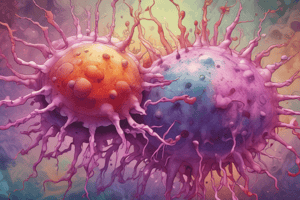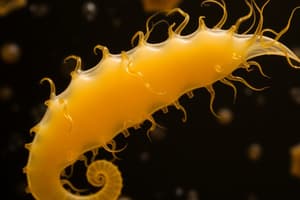Podcast
Questions and Answers
Which characteristic of Cryptosporidium oocysts is most significant for its transmission and persistence in the environment?
Which characteristic of Cryptosporidium oocysts is most significant for its transmission and persistence in the environment?
- Their bright coloration, attracting insect vectors.
- Their ability to rapidly replicate within host cells.
- Their environmental resistance, enabling survival outside a host. (correct)
- Their thin walls, facilitating easy excystation.
What is the primary difference in treatment strategies for cryptosporidiosis between immunocompetent and immunocompromised individuals?
What is the primary difference in treatment strategies for cryptosporidiosis between immunocompetent and immunocompromised individuals?
- Both groups receive the same anti-parasitic medications, but immunocompromised patients require higher dosages.
- Immunocompetent individuals require aggressive antibiotic therapy, while immunocompromised patients need supportive care only.
- Immunocompetent individuals typically receive nitazoxanide, while management in HIV patients focuses on symptom reduction alongside antiretroviral therapy. (correct)
- Immunocompromised individuals are treated with nitazoxanide; immunocompetent individuals receive paromomycin.
How does Balantidium coli differ from Cryptosporidium in terms of host specificity and reservoir?
How does Balantidium coli differ from Cryptosporidium in terms of host specificity and reservoir?
- Both parasites have similar host ranges, infecting a wide variety of mammals without specific reservoirs.
- _Balantidium coli_ uses insects as reservoirs with humans as accidental hosts; _Cryptosporidium_ has no known reservoirs.
- _Balantidium coli_ infects only pigs, while _Cryptosporidium_ is exclusive to humans.
- _Balantidium coli_ has humans as the only definitive hosts, while pigs are the reservoir; _Cryptosporidium_ primarily infects humans but can infect a wide range of zoonotic hosts. (correct)
What is the most critical distinction in the lifecycle of Balantidium coli compared to Cryptosporidium regarding the infective stage?
What is the most critical distinction in the lifecycle of Balantidium coli compared to Cryptosporidium regarding the infective stage?
Which of the following scenarios poses the highest risk for Cryptosporidium transmission?
Which of the following scenarios poses the highest risk for Cryptosporidium transmission?
In a patient diagnosed with Balantidiasis, what microscopic finding in stool samples would be most indicative of invasive disease?
In a patient diagnosed with Balantidiasis, what microscopic finding in stool samples would be most indicative of invasive disease?
Why might nitazoxanide be ineffective in treating cryptosporidiosis in an HIV patient?
Why might nitazoxanide be ineffective in treating cryptosporidiosis in an HIV patient?
How do the mechanisms of intestinal damage differ between Cryptosporidium and Balantidium coli?
How do the mechanisms of intestinal damage differ between Cryptosporidium and Balantidium coli?
Given that both Cryptosporidium and Balantidium coli can be transmitted through contaminated water, which public health intervention would be most effective in preventing the spread of both parasites?
Given that both Cryptosporidium and Balantidium coli can be transmitted through contaminated water, which public health intervention would be most effective in preventing the spread of both parasites?
What is the primary reason why paromomycin is used in HIV patients with cryptosporidiosis, despite nitazoxanide being effective in immunocompetent individuals?
What is the primary reason why paromomycin is used in HIV patients with cryptosporidiosis, despite nitazoxanide being effective in immunocompetent individuals?
Flashcards
Cryptosporidium Oocysts
Cryptosporidium Oocysts
Infective stage of Cryptosporidium, found in stool, environmentally resistant.
Cryptosporidium Trophozoites
Cryptosporidium Trophozoites
Active, feeding stage of Cryptosporidium that colonizes the intestinal tract.
Cryptosporidiosis
Cryptosporidiosis
Diarrheal disease caused by Cryptosporidium parvum and C. hominis.
Cryptosporidium Transmission
Cryptosporidium Transmission
Signup and view all the flashcards
Treatment for Cryptosporidiosis
Treatment for Cryptosporidiosis
Signup and view all the flashcards
Balantidium coli Trophozoite
Balantidium coli Trophozoite
Signup and view all the flashcards
Balantidium coli Cyst
Balantidium coli Cyst
Signup and view all the flashcards
Balantidium coli Hosts
Balantidium coli Hosts
Signup and view all the flashcards
Balantidiasis
Balantidiasis
Signup and view all the flashcards
Balantidiasis Diagnosis & Treatment
Balantidiasis Diagnosis & Treatment
Signup and view all the flashcards
Study Notes
- Cryptosporidium parvum and Cryptosporidium hominis cause cryptosporidiosis, a diarrheal disease.
- Humans are the predominant hosts, but the parasite can infect a wide range of zoonotic hosts.
- Cryptosporidium exists in three forms: oocysts, trophozoites, and sporozoites.
- Oocysts are the infective stage, thick-walled, and passed in the stool.
- Oocysts are environmentally resistant, allowing survival outside a host in feces-contaminated water, food, or within an insect vector.
- Infection occurs when an oocyst is eaten.
- Excystation of oocytes release sporozoites.
- Sporozoites invade epithelial cells of the gastrointestinal tract, typically within the brush border.
- Trophozoites are the active, feeding stage that colonizes the intestinal tract.
- Parasites undergo asexual multiplication, then sexual reproduction, forming fertilized oocysts that mature within the host.
- Mature oocysts are infectious upon excretion, enabling direct and immediate fecal-oral transmission.
- Sporulated oocysts contain four sporozoites and are excreted by the infected host through feces and possibly respiratory secretions.
- Transmission occurs through ingestion of fecally contaminated water or direct contact with infected animals or people with oocysts.
- In immunocompetent individuals, Cryptosporidium causes self-limiting diarrhea.
- In immunocompromised individuals, such as AIDS patients, it leads to life-threatening malabsorption and muscle wasting.
- Cryptosporidiosis is diagnosed through acid-fast staining of stool samples and immunofluorescence and ELISA tests.
- In non-HIV patients, treatment includes nitazoxanide.
- In HIV patients, paromomycin is used to reduce diarrhea.
- Balantidium coli is another intestinal protozoan parasite.
- Humans are the only definitive hosts and pigs act as reservoirs.
- Balantidium coli exists in trophozoite and cyst forms.
- Trophozoites are the active, feeding stage.
- Cysts are the infective stage responsible for transmission.
- Hosts acquire cysts through ingestion of contaminated food or water.
- Excystation occurs in the small intestine, releasing trophozoites.
- Trophozoites colonize the large intestine and appendix, replicating by binary fission.
- Some trophozoites invade intestinal walls, causing ulcerations and tissue destruction.
- Others return to the intestinal lumen and disintegrate, while some encyst and are passed out in feces, ready to infect a new host.
- Transmission of Balantidium coli: food and water contaminated with cysts.
- Balantidiasis is characterized by diarrhea and colonic ulcers.
- Infection ranges from asymptomatic carriage to abdominal discomfort and mild diarrhea, progressing to acute dysentery with blood and pus in the stool.
- Diagnosis of Balantidium coli: microscopic stool examination for trophozoites and cysts.
- Treatment for Balantidium coli: tetracycline and metronidazole.
- Balantidium coli is found in the large intestine, cecum, and terminal ileum.
Studying That Suits You
Use AI to generate personalized quizzes and flashcards to suit your learning preferences.




